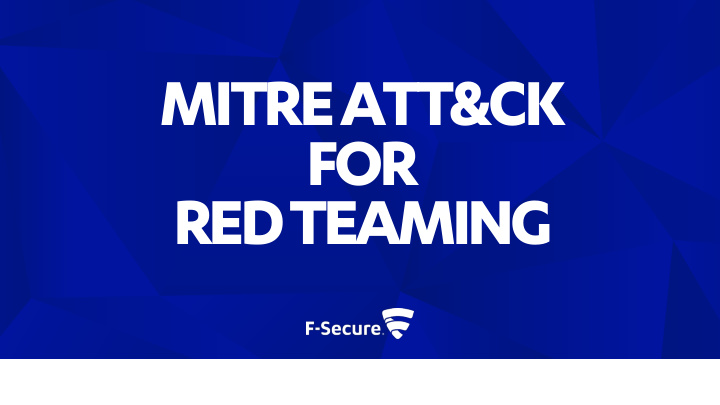



MITREATT&CK FOR RED TEAMING
ABOUT ME ▪ Niklas Särökaari – @ukk1sec ▪ Red Teamer (Senior Security Consultant) @ F-Secure
MITREATT&CK ▪ Knowledge base of adversary tactics, techniques and procedures (TTPs) ▪ Develop skills for both offense and defense to perform adversary simulations and to detect and respond to on-going attacks performed by real-world adversaries ▪ https://attack.mitre.org/
▪ swfw
INITIAL ACCESS
Initial Access Social Spear phishing Engineering Initial Access OSINT Valid Password Spraying Accounts
OPEN SOURCE INTELLIGENCE ▪ Open Source Intelligence (OSINT) gathering is used as the first step in targeted attacks and attack simulations to map the attack surface presented by a target organisation ▪ May provide crucial information that can be used to obtain initial access: ▪ Employee emails for phishing and username enumeration ▪ Publicly exposed critical services, such as Citrix and VPN portals without 2FA ▪ Lync service or Outlook Web Access, which can be abused for password spraying
SPEAR PHISHING
PASSWORD SPRAYING
PASSWORD SPRAYING
DATA COLLECTION “Defenders think in lists. Attackers think in graphs. As long as this is true, attackers win.” @JohnLaTwC
Initial Access Discovery Social Spear Engineering phishing Internal Initial Remote OSINT Access Reconnaissance Desktop Protocol Password Valid Spraying Accounts
BLOODHOUND + SHARPHOUND ▪ Provides means to collect and analyze data to identify potential attack paths ▪ SharpHound can be used to collect information such as: ▪ Local admin & user session info ▪ Group memberships ▪ Domain trusts ▪ Group Policy Objects ▪ Access Control List info ▪ Repetition is key
17
18
19
PRIVILEGE ESCALATION
Initial Access Discovery, Privilege Escalation, Credential Access & Lateral Movement Citrix Local Credential Credentials Spear Social in Breakout Privilege Dumping Engineering phishing Escalation Files (CVE-2019-1069) OSINT Internal Initial Remote Domain Access Reconnaissance Desktop Admin Protocol Privileges Access Password Valid Access Offline KeePass Token Spraying Accounts to Vault Password Manipulation Network Shares Cracking
PRIVILEGE ESCALATION ▪ Objective is to gain higher-level permissions and access on a targeted system or network ▪ Common approaches include abusing misconfigurations, exploiting known or unknown weaknesses or taking advantage of poor account management ▪ Administrative access in an environment provides wider options for an adversary to steal information and move laterally
CITRIX BREAKOUT ▪ Citrix is commonly deployed in corporate environments ▪ It is also commonly misconfigured, providing easy methods for attackers to breakout from the “sandbox” ▪ Initial access is usually a low-level user; thus escalation of privilege is required to move towards the objective
CVE-2019-1069 ▪ Previously unknown vulnerability with a proof-of-concept exploit was published affecting Windows 10 and Windows 2016/2019 servers in May 2019 by SandboxEscaper ▪ F-Secure repurposed the published PoC-exploit to create a local administrator user in Citrix servers to dump credentials for lateral movement. ▪ https://portal.msrc.microsoft.com/en-US/security-guidance/advisory/CVE-2019-1069
CREDENTIAL ACCESS
CREDENTIAL ACCESS ▪ Objective is to steal credentials, which can be used for privesc and lateral movement ▪ Commonly used techniques include: ▪ Searching files for credentials ▪ dumping LSASS with admin privileges, using Mimikatz or other similar tools ▪ Or just simple, plain old bruteforce and password spraying attacks
KEEPASSPASSWORD VAULT ▪ KeePass password vaults can be attacked with tools like John the Ripper and Hashcat ▪ “Expired” password vault that was “protected” with a 7 -character password was cracked roughly in a day ▪ The passwords recovered from the vault was then used to move laterally in the network
PASSWORD CRACKING
LATERAL MOVEMENT
LATERAL MOVEMENT ▪ Purpose is to move across the target network using obtained credentials and either legitimate administrator tools or using adversaries own tooling to achieve the objective ▪ Especially in Windows environments using RDP and administrative credentials provide wide access in the environment ▪ Environments are rarely properly segregated, which allows adversaries easily to move between systems and networks ▪ Bi-directional AD forest trusts
CONCLUSIONS
TAKEAWAYS ▪ Identify potential attack paths in your environment ▪ Unused accounts, number of high-privileged accounts, group delegated access rights, forest trust relationships ▪ Review password policies ▪ Implement 2FA for critical services ▪ Invest in detection and response capabilities ▪ And evaluate these actively
BUILDING AND MAINTAINING A ROBUST AND SECURE AD FOREST IS VERY, VERY DIFFICULT
Recommend
More recommend